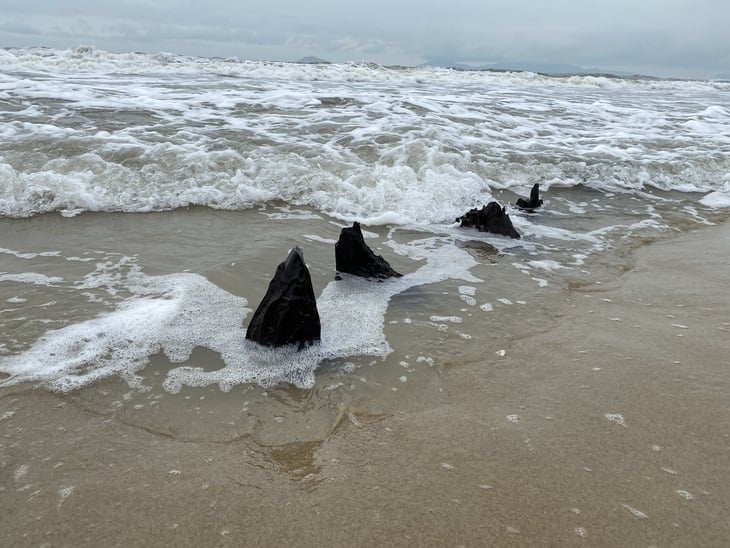
The wooden part of the sunken ship is lying at Hoi An beach - Photo: BD
On May 7, the People's Committee of Hoi An City said it was assigning the Hoi An Cultural Heritage Management and Conservation Center to coordinate with scientists and units to continue verifying information related to the shipwreck located on Cam An beach.
Fishermen say they found many ceramics and lime graves under the sea of Hoi An.
Notably, in the scientific report, experts said there was a reliable basis to determine that there was another shipwreck located about 1km off the coast, at a depth of 14-15m.
Mr. Nguyen Tan Thanh (fisherman of group 3, Thinh My block, Cam An ward) said that at a depth of about 15m, a short distance from the shore, there are currently three lime graves surrounded by walls.
While fishing, Mr. Thanh got his net caught at the bottom. When diving down, he discovered a lime grave, traces of the house floor, steps and garden, dishes, cast iron pans...
Similarly, Mr. Tran Thin (fisherman in group 1, Thinh block) also said that in 2017 he accidentally dived to the bottom of the sea a short distance from the shore and discovered a lime grave and many house foundations.
When diving south (towards Cua Dai beach), he discovered another ship with many burnt pillars, a porcelain bowl compartment and many porcelain bowls, many very large cast iron pans stacked on top of each other.
Curious, he salvaged some specimens. When scientists came down to study the wooden ship that surfaced in Cam An, Mr. Thanh provided the group with many fragments of bowls, blue and white porcelain plates, brown earthenware, and stone artifacts.
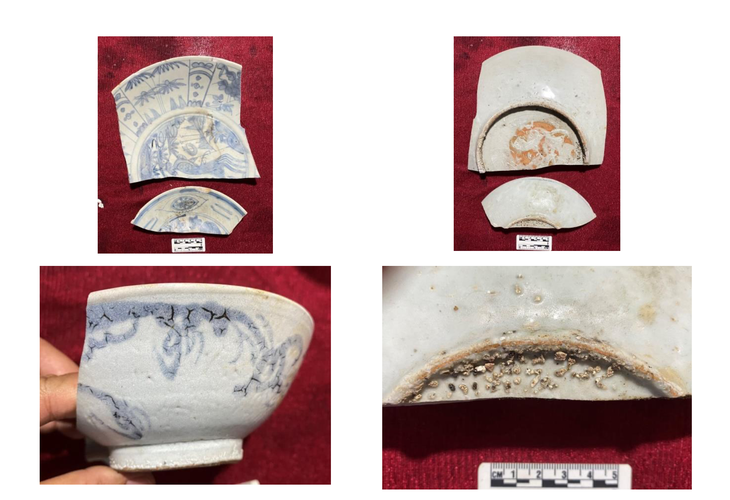
Specimens and ceramics found at Hoi An beach - Photo: BD
"There is evidence to confirm the shipwreck under the sea of Hoi An"
Regarding the information and samples provided by Hoi An fishermen, archaeologists said that the type of ceramics in Mr. Tran Thin's house was mainly Zhangzhou ware produced in southern Fujian province (China).
This type of pottery is also known as "Zhangzhou Sa Tuc" (Zhangzhou Emperor Sand). Some artifacts also have rough, cloudy glaze and dotted with dark spots on the glaze surface.
Mr. Tran Thin's artifacts show a high level of consistency not only in origin but also in the chronological framework focusing on the period from 1560 to the 1630s at the end of the Ming Dynasty.
The fact that fishermen found many cast iron pans on the seabed of Hoi An was also confirmed through investigations of shipwrecks in Southeast Asia.
Accordingly, China has a monopoly on this item. Cast iron cooking pots were found on the Pulau Buaya shipwreck from the 12th to 13th centuries along with bundles of iron blades.
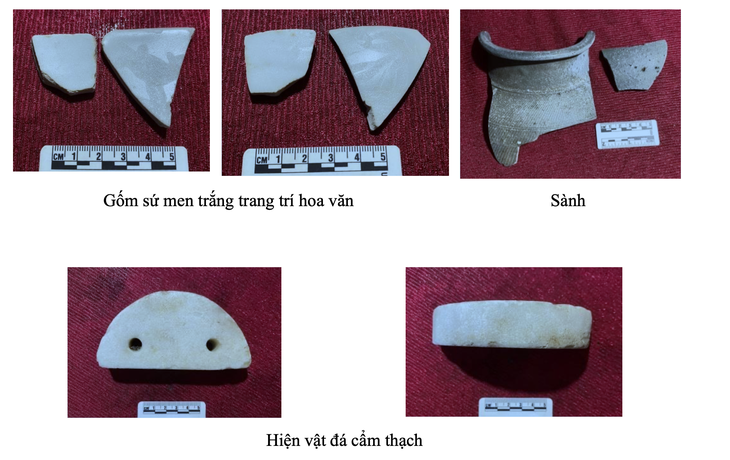
Specimens provided by local people to the team of scientists - Photo: BD
These specimens were also found on several shipwrecks in the Gulf of Thailand, a 14th-century shipwreck near Belitung, and on the Vung Tau shipwreck in 1690 en route to Batavia.
Documents from the Dutch East India Company also confirm that large quantities of pig iron were shipped from China to Java (Indonesia).
For example, in the decade 1673–1682, nine ships from Fujian province brought 55,214 iron pans, 22 pan baskets, 92 iron shovels, and six iron cannons to Batavia.
Comparing the information and collected facts, scientists said that the information about the existence of a sunken ship loaded with ceramics and cast iron objects lying at a depth of about 14-15m along the coast from Tan Thanh to Cua Dai about 1km "has a reliable basis".
Scientists suggest that a survey should be conducted soon in the Hoi An sea area to verify information about the location and cargo of the ship. From there, scientific assessments will be made as a basis for developing long-term and specific programs for protection, research, excavation, conservation, and value promotion in the future.
Mysterious ship emerges under the sand of Hoi An beach
As reported by Tuoi Tre Online , at the end of 2023, while walking on the beach, some people in Hoi An discovered the frame of a wooden boat floating on the sand in Cam An ward. The incident was reported to the authorities.
Since then, the government and cultural sector of Quang Nam have organized many activities to research the ship's history, inviting experts to evaluate information... The ship is also strictly protected.
Scientists have recently released some initial information about the origin and shape of the wooden ship. The report also mentioned information about another sunken ship lying nearby.
Source: https://tuoitre.vn/them-tau-co-cho-gom-su-noi-gang-trung-quoc-bi-dam-duoi-day-bien-hoi-an-20250507164130542.htm




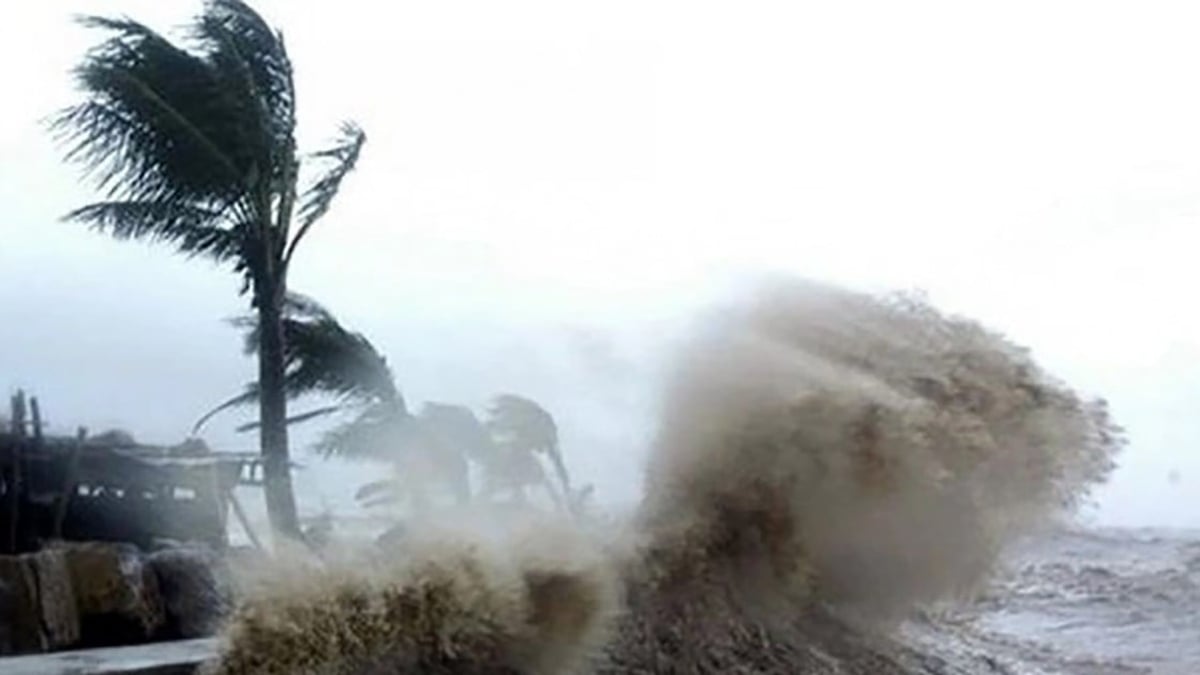




![[Video] More than 100 universities announce tuition fees for the 2025–2026 academic year](https://vphoto.vietnam.vn/thumb/1200x675/vietnam/resource/IMAGE/2025/7/18/7eacdc721552429494cf919b3a65b42e)






















































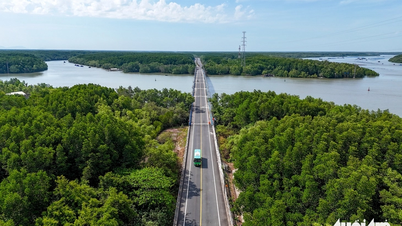
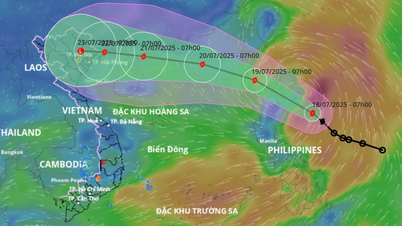



























![[Infographic] In 2025, 47 products will achieve national OCOP](https://vphoto.vietnam.vn/thumb/402x226/vietnam/resource/IMAGE/2025/7/16/5d672398b0744db3ab920e05db8e5b7d)





Comment (0)